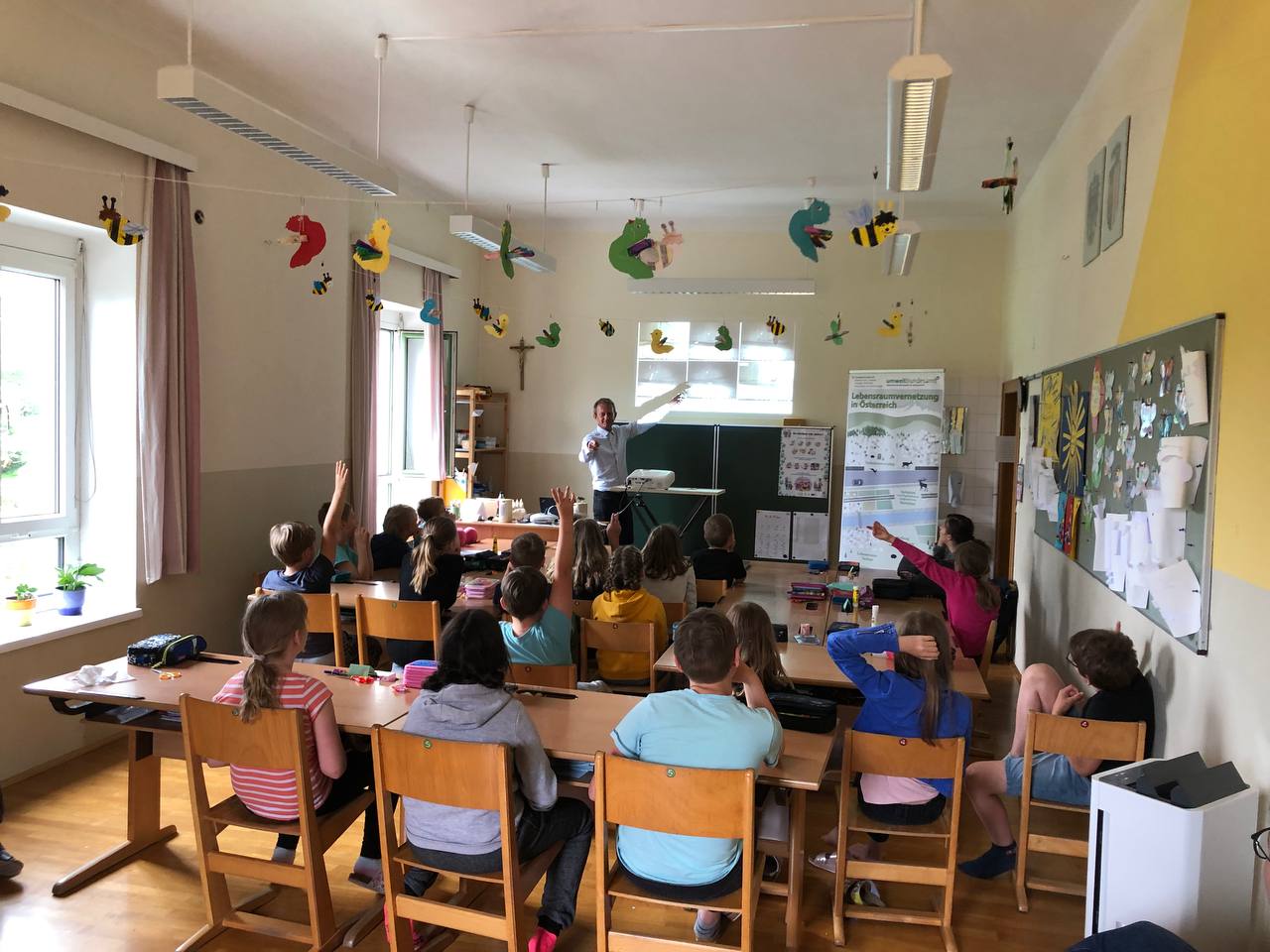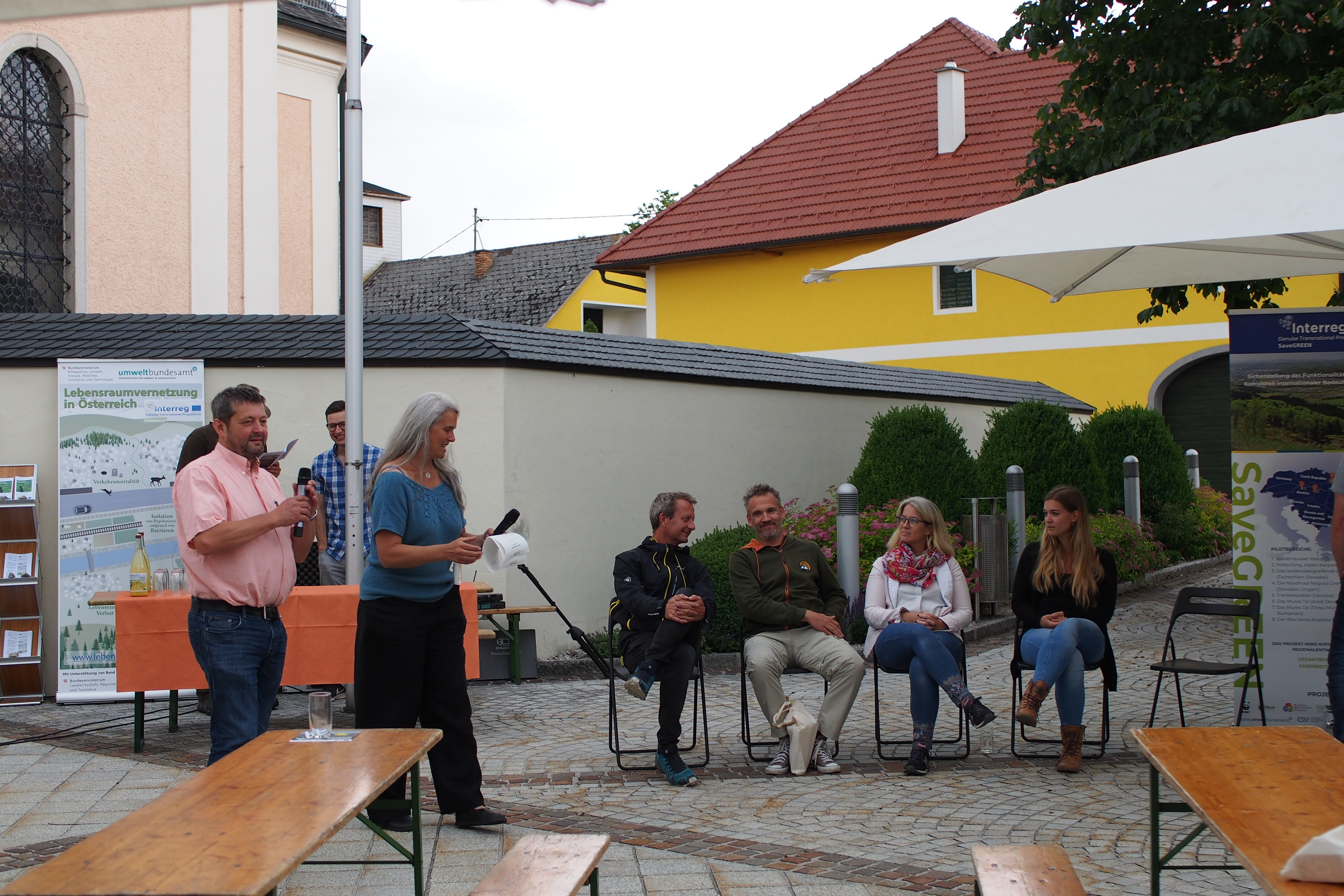SaveGREEN - InfoDay in pilot area Kobernausser forest met with great interest
16-06-2022
10 June, 2022 - Aistersheim, Upper Austria: Austrian project partners present the value of ecological connectivity during a SaveGREEN InfoDay in the Kobernausser Forest Pilot Area. In the course of the morning, 24 school children were introduced to the challenges facing migrating wildlife in Austria and learned how to identify various species of mammals based on their tracks. The afternoon saw a panel discussion on ecological connectivity in Upper Austria and possible measures to improve the current status quo.
On the 10th of June 2022, the Austrian SaveGREEN Project Partners WWF Central and Eastern Europe (WWF-CEE) and the Environment Agency Austria (EAA) joined forces with the Austrian Motorway Company ASFINAG and the Austrian Ministry of Climate Action, both Associated Strategic Partners of SaveGREEN, to organise an InfoDay on the project’s aims and activities.
Due to its location right in the centre of the Kobernausser corridor, the organisers selected the municipality of Aistersheim as a suitable location for the Austrian InfoDay. The Kobernausser corridor is the last remaining connection for wildlife seeking to migrate between the Kobernausser forest, and behind it the Alps, and Bavaria and the Czech Republic to the north. However, the highway A8 cuts right through this corridor, representing an insurmountable barrier for many animal species seeking to migrate through it. Another reason why Aistersheim was chosen for the InfoDay is the fact that the municipality lies along a stretch of the A8, between Haag am Hausruck and Meggenhofen, in which a green bridge is to be built in the near future to improve the permeability of the Kobernausser corridor.
On the morning of the 10th of June, Roland Grillmayer, EAA, and Christophe Janz, WWF-CEE, visited the Aistersheim elementary school to introduce the 2nd and 3rd-year classes to the topic of ecological connectivity. With the support of a map of ecological corridors in Upper Austria, Mr. Grillmayer showed the children the importance of their municipality and its surroundings for the coherence of the national ecological corridor network, before proceeding to brainstorm, with the active help of the children, possible steps to improve connectivity in the area and the country as a whole. Over the next hour, the 24 school children used special stamps to create a series of animal footprints in clay, which they then attributed to one of several mammal species common to the region using an identification key.

Active children at Aistersheim's elementary school (c Christophe Janz)
In the afternoon, the InfoDay began at 14:00 on the town square. Information booths were set up by the EAA, WWF-CEE on behalf of SaveGREEN, ASFINAG and the LEADER Region Mostlandl-Hausruck, each providing passers-by with material on their role in the maintenance and improvement of ecological connectivity in Upper Austria and beyond. Visitors were also invited to take home one of the project’s three giveaways: local apple juice, made from the fruit of the region’s famous orchards, local wild flowers seed packages or hand-made wooden spinning tops, produced in the neighbouring Neumarkt.
After some welcoming words by the Mayor of Aistersheim, Mr. Johann Stockinger, who underlined the importance of ecological connectivity and underlined that more had to be done to ensure the permeability of our landscapes for migrating wildlife and for conservation of biodiversity in general, a panel discussion was held at 15:00, bringing together Elke Hahn, Austrian Ministry for Climate Action, Alexandra Medl, ASFINAG, Mario Pöstinger, Ombudsman for the Environment of Upper Austria, and Roland Grillmayer, EAA. The discussion was moderated by Hildegard Meyer, WWF-CEE.

Welcoming words by Aistersheim's mayor and panelists (c Christophe Janz)
In the discussion, the speakers highlighted the immense ecological value of the Kobernausser corridor, currently being monitored by the EAA as part of the SaveGREEN project, and the importance of preserving the corridor’s permeability. The green bridge to be built by the ASFINAG across the A8 is to contribute to this effort, while spatial planning and zoning decisions at municipal and regional level need to consider current ecological corridors in order to avoid the creation of new barriers and bottleneck areas.
At 15:30, the official panel discussion dissolved into direct exchanges between the panellists and the audience, allowing for open and engaging conversations for the rest of the afternoon. In parallel to the “boring grown-ups’ stuff”, a quiz rally was held for the children attending the InfoDay, requiring them to hop from booth to booth to find the correct answers to a series of questions. The day concluded at 17:30 with the award ceremony for the quiz, which awarded Aistersheim’s new young experts on ecological connectivity with some special prizes to take home with them.

The SaveGREEN booth with giveaways and prices for the quiz (c Hildegard Meyer)
